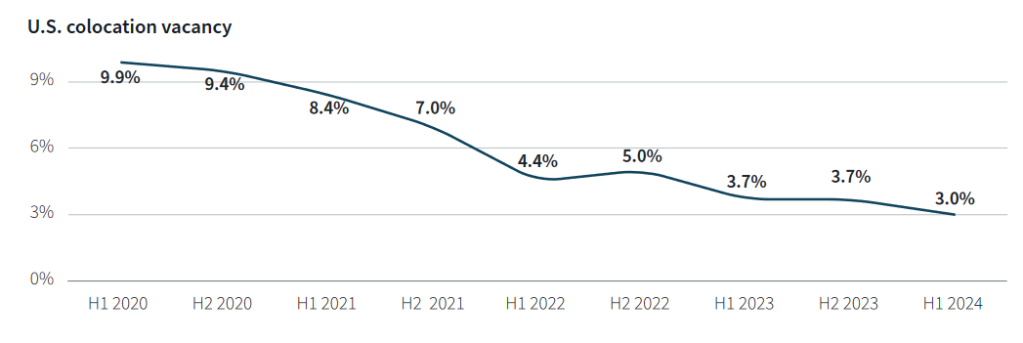Data Center Labor Shortages Take Center Stage: JLL
Amid booming demand, unfilled roles are more than twice the national average.
Finding the right talent remains a challenge for data center operators, a key issue amid rapid growth in this sector, according to a new report from JLL.
The firm’s data center report findings for 2024 indicated that the booming demand showed no sign of slowing down at midyear as vacancy set a record low of 3 percent, and occupancy has increased at a 30 percent compound annual growth rate since 2020.
Given that asking rents increased between 13 percent and 37 percent year-over-year, depending on the lease size, “There appears to be no ceiling for how high this data center demand is going to reach,” Andy Cvengros, managing director, co-lead of U.S. Data Center Markets, JLL, said in the report.
Now, the challenge is to find skilled workers to employ. An estimated 10 percent of data center roles at existing facilities are unfilled, more than twice the national average across all industries.
Given the technical nature of data centers, only about 15 percent of applicants meet the minimum job qualifications, and positions can take 60 days or more to fill.
Johnathan Meade, CEO of Meade Engineering, told Commercial Property Executive that “quality” labor is a key ingredient to the success of any company operating in the data center industry.
“Although a challenge, it is a solvable problem for the best companies,” Meade said. “As an industry, it’s our responsibility to create career pathways that appeal to a broad range of candidates. Looking beyond the traditional background and resumes is critical to the long-term success of our industry.”

“It’s also important to focus on the growth and development of talent within our organizations. Hiring is just the beginning. Targeted training programs, the ability to move between departments, and clear career paths make it easier for candidates to understand the opportunity.”
READ ALSO: First-Half Investor Darlings
Lisa Flicker, senior managing partner & head of the Real Estate group at Jackson Lucas, echoed to CPE: “The demand for talent in the data center sector is at an all-time high, yet the supply is struggling to keep pace. The war for talent is driving compensation up, and we’re seeing more unconventional hires, such as bringing in senior leaders from adjacent industries like energy or telecommunications.”
She said the core need is the skill to navigate the complexities of power management and infrastructure development.
“This cross-industry expertise is proving invaluable as data centers grapple with power constraints, fierce competition for top talent, and the rapid pace of technological advancement.”
Data center development is also expanding into rural areas with limited labor pools, presenting a unique set of staffing challenges, according to the report.
Attrition rates, especially among younger workers, also remain an issue; 33 percent of the technical workforce is at or nearing retirement age, and this number is likely to double due to demographic trends, according to the report.
Raising awareness for data center jobs
Matt Landek, managing director and U.S. Data Center Work Dynamics and Project Development and Services Lead at JLL, told CPE that until recently, many individuals were unaware of data centers and their associated career opportunities.
“With attention to data centers growing due to the AI movement, data center careers are becoming more widely known,” he said.
“If we invest the time to educate about data center career paths in school like we do others, we will see others pursue this field immediately coming out of school as we seek to staff the industry longer term,” he added.
According to Landek, employers must provide positive employee experiences and implement new approaches to solving staffing challenges while navigating fierce competition for talent and employee burnout.
READ ALSO: How to Become a Leading Data Center Market
“At the same time, the industry needs to expand the labor pool through secondary education exposure, technical development programs and outreach to underrepresented population segments,” Landek also told CPE.
He said firms should develop training programs to convert traditional technicians from other asset classes.
“Given data centers is a growing area with significant career and compensation opportunities, JLL and other organizations can look to hire individuals with foundational solid skill sets and abilities to overcome learning curves quickly from different asset classes, such as hospitals, retail, Class A properties and more.”
He suggested putting them through a defined training program that fills in the gaps between their existing skills and those needed to operate in a data center.
Add amenities and fringe benefits
Additionally, enhancing the employee experience by offering high-quality amenities and fringe benefits is necessary to attract and retain workers, as the culture of work changes and employees expect their employers to provide for them as whole people and not just employees.
“This not only includes a competitive wage, as all employees expect but also providing things that support their physical well-being, like healthy meals or meal vouchers and access to fitness centers, for example.”
Landek said partnering with trade schools and veteran employment agencies will be critical to keeping up with the demand for talent.
“There are not currently enough qualified people to fill the number of jobs open—and jobs that continue to open up—and trade schools and veteran organizations provide opportunities to recruit employees with transferrable skills and put them through the training programs to upskill,” he said.
“Building a community of practice for shared learning, including investing in continuing education and leadership development, is also necessary to keep up with changes in data center processes as technology evolves,” Landek added.








You must be logged in to post a comment.